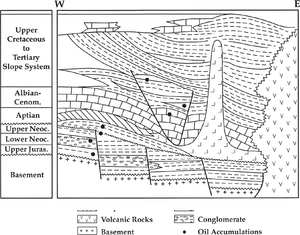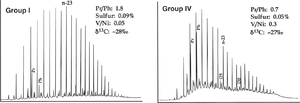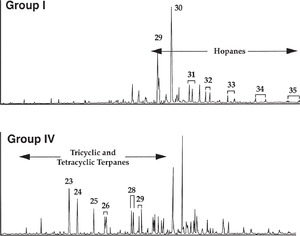Oil correlation case history: Brazilian offshore basins
| Exploring for Oil and Gas Traps | |

| |
| Series | Treatise in Petroleum Geology |
|---|---|
| Part | Critical elements of the petroleum system |
| Chapter | Oil–oil and oil–source rock correlations |
| Author | Douglas W. Waples, Joseph A. Curiale |
| Link | Web page |
| Store | AAPG Store |
The data generated when conducting a fully integrated oil–oil correlation also help determine the depositional setting of the source(s) for the oil(s). It is often possible to predict the source of an oil from its chemical composition, as illustrated by this case study. In addition, this example also presents an early approach to the use of compound concentrations (instead of biomarker ratios) as correlation parameters.
Geological setting

The offshore margin of Brazil contains oil reserves in Cretaceous and lower Tertiary reservoirs within several large basins. These basins, the product of rifting of Africa from South America in the Early Cretaceous, contain several source units representing depositional settings ranging from lacustrine to deltaic to marine.
Figure 1 is a generalized west–east cross section from the Brazilian continental margin, with the coastline approximately at the western margin. Note the wide range of depositional settings, corresponding to the wide range of potential source rocks for the five source-distinctive groups of oils in these marginal basins.
Parameters measured
To understand the source families responsible for the oils on the Brazilian margin, Mello et al.[1] measured numerous elemental, isotopic, and molecular characteristics for about 50 oils; 16 of these were examined using techniques of semiquantitative biomarker analysis. Their study is an excellent example of the importance of using diversified analytical methods. A partial list of the parameters measured includes δ13C of the whole oil; sulfur content; vanadium–nickel ratio; compound-class distribution; pristane–phytane ratio; various biomarker ratios involving diasteranes, methylsteranes, tricyclic terpanes, bisnorhopane, and gammacerane; and semiquantitative concentration data for various isoprenoids, β-carotane, selected steranes, hopanes, and oleanane. This set of parameters was then used to classify the oils into five source-distinctive groups. No one or two correlative parameters could establish these groupings—only through the combined use of several elemental, isotopic, and molecular parameters could the correlations be made and depositional settings inferred.
Group I oils, freshwater lacustrine setting

For illustrative purposes, we discuss here differences in the characteristics of group I and group IV oils.[1] The group I oils are very low in sulfur (13C values more negative than –28.0 ‰. Concentrations of diasteranes, steranes, 4-methylsteranes, and gammacerane are low; n-propylcholestanes (C30 steranes) are absent. A distinctive odd-carbon n-alkane dominance and a waxy appearance to the gas chromatogram of these oils is evident. These and other features suggest a freshwater lacustrine depositional setting.
Figure 2 represents typical gas chromatograms of saturated hydrocarbons for group I (left) and group IV (right) oils from the Brazilian continental margin. Note the many source-distinctive differences, including pristane–phytane ratio and the dominance of waxy n-alkanes in the group I oil. Supplemental numerical data indicate these differences extend to the sulfur concentration, the vanadium–nickel ratio, and the δ13C value.
Group I and group IV oils contrasted

In contrast to group I oil, group IV oils contain significantly higher levels of sulfur, higher vanadium-nickel, less negative δ13C ratios, and lower wax contents (see Figure 8-49). Sterane concentrations are high, as are concentrations of n-propylcholestanes. In addition, tricyclic and tetracyclic terpanes are present in relatively higher concentration in group IV oils, and the homohopane distribution is irregular, with high C33.
Figure 3 illustrates typical m/z 191 mass chromatograms for group I (top) and group IV (bottom) oils from the Brazilian continental margin, showing the differences in terpane distributions. A marine carbonate depositional setting for the source of group IV oils is reflected in the high abundance of tricyclic and tetracyclic terpanes, in the high C33 homohopane concentration, and in the low wax content.
Geological conclusions
These source-distinctive correlational groupings are supported by geographical and geological considerations. The group I oils occur in the central Brazilian basins in sandstone reservoirs of mid-Cretaceous age juxtaposed with coeval lacustrine source rocks. In contrast, group IV oils occur in the northernmost basins in Upper Cretaceous and lower Tertiary reservoirs.
What this case study illustrates
This case study demonstrates the utility of compound concentration data and emphasizes the use of routine oil–oil correlation data in predicting the depositional setting of oils. Later efforts have confirmed several of these predictions using similar correlation tools on prospective source rocks in the region.[2] The resulting oil–source rock correlations are supported by a similarly wide range of analytical approaches.
See also
References
- ↑ 1.0 1.1 1.2 1.3 1.4 Mello, M. R., P. C. Gaglianone, S. C. Brassell, and J. R. Maxwell, 1988a, Geochemical and biological marker assessment of depositional environments using Brazilian offshore oils: Marine and Petroleum Geology, vol. 5, p. 205–223, DOI: 10.1016/0264-8172(88)90002-5.
- ↑ Mello, M. R., N. Telnæs, P. C. Gaglianone, M. I. Chicarelli, S. C. Brassell, and J. R. Maxwell, 1988b, Organic geochemical characterisation of depositional palaeoenvironments of source rocks and oils in Brazilian marginal basins: Organic Geochemistry, vol. 13, p. 31–45, DOI: 10.1016/0146-6380(88)90023-X.